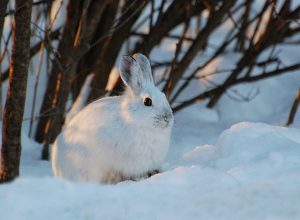Snowshoe Hare
Found in the Alpine region, the snowshoe hare is an interesting animal as it changes color according to the season. Either stays in groups or alone, the hare populates rapidly.
Scientific Classification
| Kingdom | Animalia |
| Phylum | Chordata |
| Class | Mammalia |
| Order | Lagomorpha |
| Family | Leporidae |
| Genus | Lepus |
| Scientific Name | Lepus americanus |
Quick Information
| Also Known as | Snowshoe rabbit and varying hare |
| Description | Size: 16-20 in (40.64-50.8 cm); Tail length 0.98-2.1 in (2.5-5.5 cm) Weight: 32-64 oz (0.90-1.8 kg) Color: White throughout the winter and brown during the summer |
| Subspecies and Distribution | 1. Lepus americanus americanus (Erxleben) – Saskatchewan, Alberta, Manitoba, Ontario, Montana, and North Dakota 2. L. a. columbiensis (Rhoads) – Washington, British Columbia, and Alberta 3. L. a. cascadensis (Nelson) – Washington and British Columbia 4. L. a. oregonus (Orr) – Oregon 5. L. a. klamathensis (Merriam) – California and Oregon 6. L. a. tahoensis (Orr) – Western Nevada and California 7. L. a. phaeonotus (J. A. Allen) – Michigan, Minnesota, Ontario, Saskatchewan, Wisconsin, and Manitoba, 8. L. a. pallidus (Cowan) – British Columbia 9. L. a. dalli (Merriam) – Mackenzie District, Alaska, British Columbia, Yukon 10. L. a. virginianus (Harlan) – Ontario, Massachusetts, Quebec, New Hampshire, Maryland, Maine, Vermont, North Carolina, New York, Virginia, Tennessee Pennsylvania, Ohio, and West Virginia 11. L. a. struthopus (Bangs) – Newfoundland, Maine, Prince Edward Island, Nova Scotia, Quebec, and New Brunswick 12. L. a. seclusus (Baker and Hankins) – Wyoming 13. L. a. washingtonii (Baird) – British Columbia, Oregon, and Washington 14. L. a. pineus (Dalquest) – British Columbia, Washington, and Idaho |
| Habitat | Coniferous forests with thickets, swamps, and undergrowths |
| Sound & Calls | They snort to express annoyance, squealing sound to defend themselves, emits a clicking noise during the courtship and calling for young hares |
| Lifespan | Around 5 years |
| Diet | For summer: Leaves, ferns and grasses For Winter: barks, buds, and twigs |
| Adaptations | 1. Their fur color changes to camoflouge, some of the hares can stay brown throughout the year as a part of adaptation, though it doesn’t serve the purpose. 2. Their hind feet are large and well adapted to run on the snos. The feet are also coated with fur to keep them warm. 3. Their ears have many veins that regulate their body temperatures |
| Predators | Coyotes, foxes, lynxes, and bobcats |
| IUCN Conservation Status | Least Concern |
Behavior
- Snowshoe hares are nocturnal and always have their food at night
- They are fast runners and usually change direction quickly, and creating obstructions with leaves to ward off predators
- They can swim extremely well and jump in the water in order to run away from predators
Mating and Reproduction
Breeding seasons starts in March for snowshoe hares and males compete for their potential matches. After mating, followed by a gestation period of 36 days, females have 2-4 litters yearly, each including 1-8 young hares or leverets.
Life-cycle
Snowshoe hares are born being fully covered with fur and eyes open. They weigh 1.5-2.6 oz at birth. After a few hours of their birth, they are able to hop. They become fully self dependent after 3-4 weeks. They attains sexual maturity at the age of 1.
Interesting Facts
- Snowshoe hares can jump upto 3 meters and they are fast as well. Their general speed is 27 miles per hours.
- They efficiently munch on pine needles.
References
- https://animalcorner.org/animals/snowshoe-hare/
- https://www.hww.ca/en/wildlife/mammals/snowshoe-hare.html
- https://animaldiversity.org/accounts/Lepus_americanus/
- https://www.nationalgeographic.com/animals/mammals/facts/snowshoe-hare
- https://www.cbc.ca/kidscbc2/the-feed/fun-facts-about-cute-animals-snowshoe-hare-edition
Published on May 11th 2019 by Sahana Kanjilal under Coniferous Forest Animals.
Article was last reviewed on 5th December 2022.









